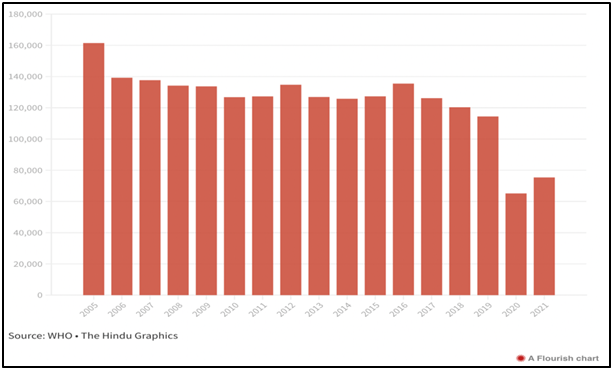Why in the News?
- The Central government has approved a new treatment regimen for leprosy, aiming to stop its transmission at the sub-national level by 2027, three years ahead of the UN’s Sustainable Development Goals.
What’s in Today’s Article?
- About Leprosy (Basic Details, Transmission, Prevalence, etc.)
- Leprosy in India (Statistics, National Leprosy Elimination Programme)
- News Summary
About Leprosy:
- Hansen’s disease (also known as leprosy) is an infection caused by slow-growing bacteria called Mycobacterium leprae.
- It can affect the nerves, skin, eyes, and lining of the nose (nasal mucosa).
- Leprosy produces skin ulcers, nerve damage, and muscle weakness. If it isn’t treated, it can cause severe disfigurement and significant disability.
- Early treatment may prevent additional tissue damage and stop it from spreading further.
Transmission of Leprosy:
- The disease is transmitted through droplets from the nose and mouth.
- Prolonged, close contact over months with someone with untreated leprosy is needed to catch the disease.
- The disease is not spread through casual contact with a person who has leprosy like shaking hands or hugging, sharing meals or sitting next to each other.
- Moreover, the patient stops transmitting the disease when they begin treatment.
Prevalence of Leprosy:
- Leprosy is one of the oldest diseases in recorded history. The first known written reference to Hansen’s disease is from around 600 B.C.
- It is a Neglected Tropical Disease (NTD) which still occurs in more than 120 countries.
- NTDs are a diverse group of conditions caused by a variety of pathogens (including viruses, bacteria, parasites, fungi and toxins) and associated with devastating health, social and economic consequences.
- In 2022, 182 countries accounted for a registered prevalence of 1,65,459 cases and 1,74,087 new cases of leprosy.
Prevalence of Leprosy in India:

- Despite India being declared “Leprosy Eliminated” in 2005, the country still accounts for over half (52%) of world’s new leprosy patients.
- Arunachal Pradesh, West Bengal, Bihar, Jharkhand, Odisha, Chhattisgarh, Maharashtra, Uttar Pradesh, Delhi, Madhya Pradesh, Gujarat, Dadra Nagar Haveli and Daman Diu have either one or more districts (total 82 districts) which are yet to achieve leprosy elimination target.
National Leprosy Eradication Programme (NLEP):
- NLEP is a centrally sponsored scheme under the umbrella of National Health Mission (NHM).
- NLEP is aimed to bring down Prevalence Rate of leprosy:
- To less than 1/10,000 population at district level;
- Grade II Disability rate per million population to Zero at district level;
- Grade II Disability to Zero among new cases and
- Child leprosy cases to zero level.
- It also aims at generating awareness about leprosy disease.
- Major initiatives under NLEP are as follows:
- Leprosy Case Detections Campaign (LCDC) in high endemic districts.
- Focused Leprosy Campaign (FLC) in low endemic districts for case detection.
- Special plans for Hard-to-Reach areas for early case detection and treatment.
- ASHA Based Surveillance for Leprosy Suspects (ABSULS).
- Sparsh Leprosy Awareness Campaign on 30th January every year.
- Active Case Detection and Surveillance both in rural and urban areas.
News Summary:
- According to a letter written by the Directorate General of Health Services (DGHS), the National Leprosy Eradication Programme is taking all the required steps to stop the transmission of leprosy.
- The Government has approved a new treatment regimen for leprosy, aiming to stop its transmission at the sub-national level by 2027, three years ahead of the UN’s Sustainable Development Goals.
- The Ministry of Health and Family Welfare has decided to introduce a three-drug regimen for Pauci-Bacillary (PB) cases in place of a two-drug regimen for six months.
- It further added that the World Health Organization (WHO) had agreed to supply the revised drug regimen from April 1, 2025.
- Thus, all States and Union Territories have now been asked to send their requisitions for anti-leprosy drugs 12 months beforehand.









